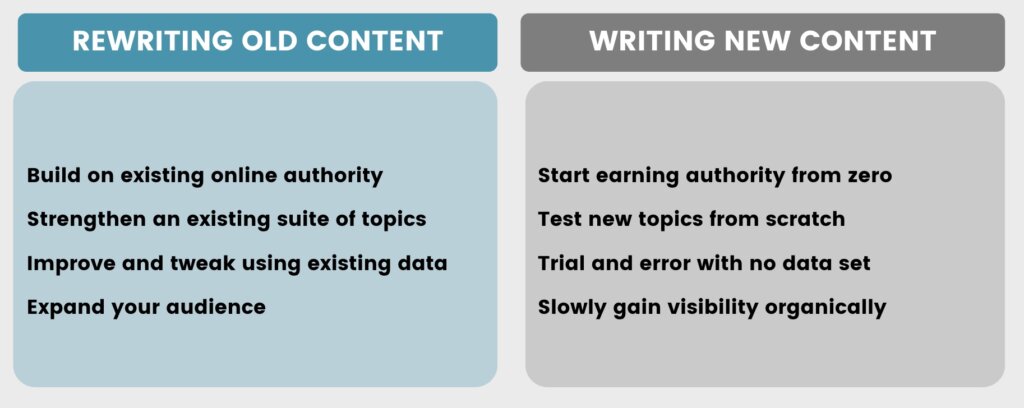The best kept secret in content strategy is that you can drive additional traffic by simply improving and updating your existing content. A rewrite can be a highly valuable, highly underrated contribution to your SEO—if performed properly.
Search engine algorithms are constantly evolving, prioritizing quality and relevance. Herein lies the power of the rewrite. By refreshing outdated content, you signal to search engines that your website is current and authoritative. From an E-E-A-T perspective, this is a huge factor in gaining trust. Strategic tweaks to keywords, meta descriptions and headers can breathe new life into existing pages, elevating their visibility and driving organic traffic.
Let’s delve into why revamping existing pages can be a game-changer for your legal marketing strategy, and how to go about deciding and rewriting to achieve maximum SEO benefits.
There are major SEO benefits to rewrites vs. creating a new page.
SEO requires that you produce relevant, valuable, fresh content to be indexed by the search engines.
While you can do SEO with both new and old content, there are some time-saving and strategic advantages to updating your existing content as opposed to investing in a full suite of new content from scratch.
In a lot of cases, the SEO benefits of rewrites far exceed the benefits of crafting new content.

Rewrites build on existing trust: Existing content may already have backlinks or other positioning on the search engines. By improving the scale and depth of your topic coverage and expanding it with expert and unique perspectives that add value, you’re basically adding a power-up of SEO juice to content that is already experiencing some level of success.
Rewrites strengthen your tested niche: You already know which topics are yielding the most traffic within your target audience, based on the blog posts that are performing the best. This allows you to double down on existing content and topics with some certainty about the results.
Rewrites give a baseline for tweaks: With existing data on traffic and conversion, you can embark on targeted A/B testing in a rewrite to optimize for your goals. If you create new content from scratch, on the other hand, you have to wait to get a baseline for performance and you’d know less about which aspects are contributing to that success, delaying your results.
Rewrites are optimized for faster visibility: Existing content has already been indexed by Google. It already has some positioning and visibility on Google. Even if your existing content is not ranked as highly as you’d like, it’s still further ahead in the ranking game than brand new content that has never been indexed. You can add a new CTA to existing content and get eyes on it faster than you would with brand new content.
The key to rewrites, of course, is to pick the right content to rewrite. Not all content should be rewritten.
Before you rewrite, consider all your options.
Consider the following factors when deciding whether a page deserves to be rewritten:
- Relevance: Does the page address current legal trends and client needs?
- Engagement: Are visitors staying on the page, or is there a high bounce rate?
- Conversion: Is the content driving desired actions, such as inquiries or consultations?
- Competition: How does the page compare to similar content offered by competitors?
A content audit can help you lay the groundwork for a targeted rewrite strategy, beginning with grouping your existing content into several categories:
Revamp: High-performing content
Rewrite: Low-performing content on topics that address client needs or drive desired actions
Combine: Similar pages with similar keywords to avoid content cannibalization
Delete: Low-performing content that does not address client needs or drive desired actions
Don’t exclude evergreen content from your consideration list. This kind of content may need to be updated if new evidence has arisen. It can certainly be improved based on best SEO practices.
Steps in a rewrite: refresh, editing and restructuring—but first understand
Let’s be very clear: Rewriting does not mean completely restructuring and wiping out an existing article but just keeping the title and URL. Instead, rewrites and revamps mean that you work gently and thoughtfully with the existing content, understanding what is working and what isn’t.
Rewrites are a bit like renovating a tower of wooden blocks. You can do a bit of rearranging and removing, but you shouldn’t fundamentally destroy what is already there or else the tower might come tumbling down.
Start by understanding the search intent for the content. Be very clear about why people are coming to this page. Your goal is to conclude the user journey on your page.
Then, consider ways to improve (and what to keep the same). Review how your competitors are handling the same topic. Do some Hotjar testing to find out which parts of the content are getting the most and the least attention.
Finally, embark on your rewrite. Ensure the content is accurate and up-to-date. Make sure it aligns with your current branding and messaging. Improve the headers, meta descriptions and keywords. Embrace formatting elements for scannability and incorporate charts or graphics for visual interest where appropriate.
Review and next steps
Ultimately, content management requires data and long-term strategies. Rewrites are a valuable tool in your toolbox for breathing new life into existing content and growing your visibility with less work and better outcomes.
Instead of starting from square one, rewrites allow you to build upon a foundation already recognized by search engines and visitors. This approach not only saves time but also ensures that your efforts are focused on refining, rather than reinventing.
Get help transforming your online presence into a value-packed growth machine for your law firm. From content marketing to website design, Omnizant is an agency that offers a full suite of expert support for growth-oriented law firms.

